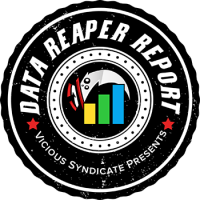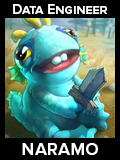
Welcome to the 56th edition of the Data Reaper Report!
Our Data Reaper Project, including the Data Reaper Live (Beta) has 2,200 active contributors. Without them, this project would not be possible, so we’d like to thank all of our contributors for their help.
Quick Links
Class/Archetype Distribution | Class Frequency | Matchup Winrates | vS Power Rankings | Class Analysis & Decklists | Meta Breaker of the Week | How to Contribute | Credits
Number of Games
| Overall | 65,000 |
| Legend | 5,000 |
| Ranks 1-5 | 20,000 |
| Ranks 6-10 | 17,000 |
| Ranks 11-15 | 15,000 |
Class/Archetype Distribution
Class Frequency by Day
Class Frequency by Week
Class Frequency Discussion
The change to The Caverns Below has had a significant impact on the Un’Goro meta. What it didn’t do, however, is usher in a control meta. We’ve said in our last report that, while Crystal Rogue was suppressing the performance of control decks, it was also suppressing the performance of Jade Druid, a notorious “control killer”. Jade Druid’s popularity jumped at the very second Crystal Rogue vanished and has seemingly taken its spot in the meta. It is only at legend ranks where we see Token Druid surpassing Jade Druid in its play rates.
The Mage class is a tale of two meta’s. At lower levels of play, Burn Mage is still the most popular archetype, with Secret Mage being a close second. However, at legend ranks, Freeze Mage’s numbers are double those of Burn Mage, with the latter looking fairly niche in comparison. Overall, the Mage class has seen a slight decline in its play rates and it is attributed to the collapse of Burn Mage’s numbers. Secret Mage, in contrast, has seen an uptick in play across all levels.
Rogue has taken a hit with the disappearance of Crystal Rogue but has brushed it off pretty quickly. Miracle Rogue has filled the void and jumped in its popularity across all levels of play. Note that Miracle Rogue’s numbers at legend are particularly high, doubling the numbers outside of legend, which is a typical pattern for the class. Interestingly, Jade Rogue has established modest representation as well.
Warrior refuses to budge even when the meta is changing all around it. We do notice that there are more Pirate Warriors and less Taunt Warriors at legend, with the top end players wary of running into Jade Druids, but unlike other classes, Warrior hasn’t seen any internal changes in its card usage.
Paladin continues its cluster shift, which was beginning before the balance changes. After studying the U.K Paladin build, we’ve concluded that this small cluster is closer to the Midrange archetype than the Aggro one in terms of its play pattern and matchup performances, so we’ve made a recognition adjustment by moving it to the former. The class has seen a big spike in play at legend, where it was usually played less. Both Midrange and Control Paladin are quite prevalent, with the Aggro cluster fading away in comparison.
Shaman has seen a spike in play, and it’s attributed to Midrange Shaman builds significantly rising in popularity. This archetype was nearly dead before the balance changes, and the disappearance of Crystal Rogue has led to it being given a new chance at establishing itself in the meta. The archetype is highly diverse at the moment, with many different routes attempting to take advantage of the Jade/Elemental synergy, which was further enhanced by the Elemental tag given to Jade Spirit.
The class that has changed the most as a result of the balance change is Priest, though you wouldn’t know it if you just looked at the charts. The main shift is a convergence between the Control Priest cluster and the Dragon Priest cluster. Translation: Decks that have a Control Priest shell and use a minimal amount of Dragons just for the sake of utilizing Drakonid Operative as a value generator are becoming popular. While that has always been the case to some degree (since the rotation, Dragon Priest hasn’t been a tempo-focused deck), it’s reached a point post-patch where it’s a bit problematic to segregate the clusters with the required accuracy we would like. Since we’re very sensitive to these issues, we merged the clusters for now and will look to see how the class continues to evolve. If testing indicates we can once again separate them with great confidence, we will do so, but at the moment, they are behaving very similarly.
The balance change did not change Hunter and Warlock’s fortunes. Hunter has seen an overall decline in play since the patch and its play rates at legend are extremely low, while Warlock still looks dead in the water.

vS Power Rankings Discussion
Before we get into the delicious, juicy details of the meta post-patch, note that since we’ve reset the data from the day of the patch, we don’t have enough legend games to apply its win rates on the legend table. This means that the legend table mostly takes frequency into account. Legend win rates will likely be available next week. Keep this in mind as you read on.
A couple of weeks ago, we’ve earmarked three decks that we felt were going to significantly impact the meta after the patch: Jade Druid, Miracle Rogue and Midrange Paladin. We never expected to see a rise in control decks, but a rise in different anti-control decks (as well as games slowing down to some degree). In addition, the latter two are fantastic counters to Jade Druid, so a rise in this archetype’s play rates should lead to a more favorable meta for them. It certainly has.
While Jade Druid was the first deck players jumped onto after Crystal Rogue vanished into thin air, it has been heavily targeted by the meta. The increased presence of Miracle Rogue, especially at legend ranks, has beaten down Jade Druid relentlessly. Top end Pirate Warriors started running Bittertide Hydras and we’ve seen other archetypes trying similar adjustments. Jade Druid’s score at legend is an indication of the meta focusing its efforts to destroy it.
Crystal Rogue’s effect on Miracle Rogue was crippling, and now the latter has found new life beating down on Jade Druids and Priests. Many players have had success at the top legend ranks with Miracle Rogue over the past week, and its win rate is climbing as of this moment since a post-patch build is still being refined. However, aggressive decks and Mages are around, and every day brings more attention to the archetype that’s hovering around the 50% mark. Even if we take its known skill cap into account, it’s hard to imagine a meta where Miracle Rogue’s win rate becomes truly elite, but it’s certainly a stronger deck now, by far.
Speaking of truly elite, Midrange Paladin is a bit ridiculous right now. It’s probably the best deck in the game if you’re interested in quickly climbing ladder, and its score is only slightly curbed at legend due to the increased presence of its primary counters, Token Druid and Pirate Warrior. We can already sense people adding Hungry Crabs to their decks as they’re reading this. Control Paladin has mostly stayed put. Its counters were simply replaced and these counters became the new prey for the established aggressive decks.
Who’s the biggest loser of the balance change? It appears to be the Mage class. Jaina has come under a lot of fire lately due to cards such as Ice Block and Primordial Glyph, but her strength before the patch was very meta dependent. Mage thrived because Ice Block was strong when the meta was dominated by a combo deck that killed you on turn 7 and aggressive decks that try to kill that combo deck before turn 7. Spice up the meta with more healing and armor gain and the class looks much more reasonable. Freeze Mage will likely stay strong because of its great matchup against Miracle Rogue, which is evident by its score at legend, but Burn Mage almost seems outdated. The best Mage deck right now is actually Secret Mage, since it has good matchups against both Jade Druid and Miracle Rogue.
Both Warrior archetypes look stronger than before. While Taunt Warrior suffers from the Jade Druid matchup, Miracle Rogue is a closer affair that results in a net gain from the disappearance of Crystal Rogue. Pirate Warriors keep bashing Rogue faces, no matter what cards they play, and as Jade Druids have gotten a little greedier, Pirate Warrior adjusted to improve a matchup that was quite even before the patch. SMOrc is still king.
Token Shaman, much like the other popular aggressive decks, cares little for the balance change, but its slower cousin sure does. Midrange Shaman has become playable, after being unplayable. Considering that the archetype is still very diverse and in an experimental phase, there is some hope it could improve further. However, it still has some deficiencies in certain matchups that could keep its win rate as modest as it currently is.
Finally, let’s talk about the oddball decks, and we have quite a statement to make. “EZ BIG EZ DRUID EZ”, scientifically known as the Un’Goro reincarnation of Ramp Druid, can no longer be considered a meme. It is a legitimately strong deck and superior to Jade Druid in the current meta. Let that sink in. While its weaknesses are similar to Jade Druid’s, such as a horrid matchup with Midrange Paladin, it destroys Burn/Freeze Mages just as effectively and performs better against Miracle Rogue and Priests due to the ridiculously swingy plays it is capable of. In addition, it annihilates Jade Druid in the mirror. We think it’s time to pay serious attention to this archetype. Its performance level in a field that’s prepared for it is an open question, for which we are seeking an answer. Another deck that you can notice has spiked to a very good win rate despite a low play rate is Silence Priest, and its ability to dominate Jade Druid is the primary cause of its increased score. It also performs better outside of legend due to the discrepancies in Miracle Rogue’s popularity.
Midrange Hunter is a worse deck as a result of losing the only matchup it actually performed well in, while Warlock is still a barren wasteland. We don’t expect great things from Jade Rogue either, but it is an archetype that’s in an experimental phase, so positive things could develop there. The same could be said for Priest, which is the most volatile class at the moment in terms of its card usage. We could definitely see a consistent build breaking out from the chaos and doing well.
If you’re wondering about Crystal Rogue’s post-patch performance levels, the deck is not being played much which makes its sample size a bit lackluster. However, our estimate based on this sample size is that the archetype’s win rate dropped by about 15% and is lingering in the mid 30’s. RIP in pepperoni.
Class Analysis & Decklists
Druid | Hunter | Mage | Paladin | Priest | Rogue | Shaman | Warlock | Warrior
Jade Druid has seen a surge in play on the back of the nerf to The Caverns Below, as Crystal Rogue was its most difficult matchup. While there are other counters to Jade Druid that keep it in check, such as Midrange Paladin and Miracle Rogue, it should be a much better deck to climb with than before.
Token Druid maintains a strong place in the meta, as it has strong matchups against other aggressive decks, such as Pirate Warrior. However, its popularity has dropped somewhat due to the disappearance of its best matchup, Crystal Rogue. With Midrange Paladin on the rise (and some of its builds running pirates as well), a list that runs the full crab package is looking strong.
Ramp Druid (a.k.a. EZ BIG EZ Druid) also benefits from Crystal Rogue’s demise, as the Druid deck struggles to put on pressure early, and lacks removal to handle a board of 5/5s. Xixo hit #3 legend with the deck this week, with the archetype slowly growing in popularity and looking promising at initial glance in the post-patch metagame.
Mage has certainly been negatively affected by the balance change that dissolved Crystal Rogue, but it is still a very strong class with the ability to adjust to the changing field. Its strength against the Rogue class remains very relevant, especially at higher levels of play where Miracle Rogue is particularly popular, but it certainly needs to be mindful of the presence of Jade Druids as well as Priests.
Freeze Mage continues to see success, especially through hybrid builds that can improve win rates against the decks that are meant to counter Freeze Mage. GeorgeC is maintaining a top 10 spot with his Medivh Freeze Mage list; while Grothen took the #1 spot on EU with Zalae’s Mana Wyrm hybrid build by swapping Bloodmage Thalnos with Medivh. Medivh is becoming more popular than Antonidas recently because of its ability to apply board pressure to complement your direct damage spells. It synergizes very well with your freeze effects by disrupting your opponent’s ability to trade into your board pressure while gaining valuable and repetitive minion damage.
Secret Mage is looking stronger than ever because unlike other Mage decks, it relishes the matchup with Jade Druid. Fenom added Arcane Giants to the deck, an idea which was originally popularized by Surrender, taking advantage of the fact that aggressive decks can afford to play slightly slower now without Crystal Rogues running around. The Arcane Giants synergize perfectly with the spell heavy build and provide further back breaking pressure on Jade Druids. The secret package can be changed; with one Ice Block being a strong alternative by enabling your Valet’s more consistently while also providing racing potential against aggressive decks.
Burn Mage has fallen behind and feels a bit outdated for the current meta. While it does perform better than Freeze Mage against decks such as Priest and Taunt Warrior, it’s not enough to overcome its inconsistency in aggressive matchups.
- Mage Class Radar
- Laughing’s Freeze Mage
- GeorgeC’s Medivh Freeze Mage
- Grothen’s Hybrid Freeze Mage
- Ant’s Secret Mage
- Fenom’s Giants Secret Mage
- Muzzy’s Burn Mage
- GeorgeC’s Burn Mage
Crystal Rogue is gone. The balance change has killed the deck off, with its representation nearly being non-existent.
This gap has largely been filled by Miracle Rogue, which has benefitted greatly from the shift in the meta and sees its greatest representation at the highest levels of play, where many players have found success with the archetype. The deck’s greatest strength in the current meta is its ability to bully Jade Druids, while still being able to fight against aggressive decks much more effectively than Crystal Rogue did. Taking the aggressive decks into consideration, most lists are utilizing SI Agents.
Villains’ list, which was piloted by Caravaggio who peaked at #3 legend, is the most standard and “vanilla” build and is a strong all-around choice. However, there are many flex cards which are currently seeing play. To tech against control, Questing Adventurer can be added instead of SI Agent for an additional threat. Burgly Bully also serves a similar purpose, while even Elise the Trailblazer has been experimented with by Weghuz on his climb to the top 100. Sap is also an option if you’re encountering many Paladins in order to provide a strong answer to a Spikeridged Steed.
An archetype that has made an appearance as a result of the balance change is Jade Rogue. There are currently two main approaches to the archetype. The first runs N’Zoth, taking advantage of the deathrattle synergy with Aya Blackpaw, Jade Swarmer and Journey Below. The second incorporates the Jade package into the Miracle Rogue shell.
It will be interesting to see whether Jade Rogue exits its refinement stage as a legitimately competitive deck, or whether Miracle Rogue will be the only Rogue deck left standing. Other Rogue archetypes are not seeing any significant amount of play at the moment.
The change to The Caverns Below has worked out about as well as it could for the Warrior class. Although the disappearance of Crystal Rogue means Pirate Warrior lost a good matchup, it is made up for by a huge spike in Miracle Rogue, a matchup which is nearly as strong. When you factor in the rise of Midrange Paladin as well, it leads to a very favorable meta for the deck. However, the emergence of “UK Paladin” with Dread Corsairs will encourage more decks to make room for Golakka Crawlers, so be wary of this potential obstacle in the deck’s performance against the field.
There’s little difference in Pirate Warrior lists. The standard build will have some combination of Naga Corsairs, Mortal Strikes, Spellbreaker and Captain Greenskin. Xzirez hit #1 with a different Pirate Warrior list that runs Bittertide Hydras. The purpose of the Hydras is to improve the matchups against Jade Druid and Freeze/Burn Mages. Druids naturally don’t have an answer to a big minion, and Mages will often find it awkward to deal with one as well.
The balance change was predicted to be good news for Taunt Warrior, and it has been. While some of the “anti-control slack” has been picked up by Jade Druid, Miracle Rogue is a much less miserable matchup for the deck than Crystal Rogue. With the meta remaining quite aggressive in its nature, Taunt Warrior also still has its dominating matchups against Token Druid and Token Shaman to fall back on.
- Warrior Class Radar
- Standard Pirate Warrior
- Xzirez’ Pirate Warrior
- Eloise’s Taunt Warrior
- RayC’s Taunt Warrior
- Fibonacci’s Control Warrior
Token Shaman is largely unaffected by the balance change to The Caverns Below, at least on the surface. It is an aggressive deck at its core, but is more than capable of long protracted games. While the standard list has remained steady, some experiments are being done to take advantage of the Elemental tag which was given to Jade Spirit, as well as the fact that Bloodlust isn’t as critical of a win condition as it was against Rogue. Eloise’s build drops the deck’s taunt package for an elemental package consisting of Jade Spirit, Servant of Kalimos and Kalimos. This weakens the deck in aggressive matchups but significantly increases its longevity against control.
Midrange Shaman, on the other hand, is far happier to see Crystal Rogue gone, an archetype that made it literally unplayable on ladder. While Midrange Shaman is certainly stronger at the moment, it is still some way behind the top meta decks due to its struggles against Jade Druid, Token Shaman and the Mage class as a whole.
- Shaman Class Radar
- Standard Token Shaman
- Eloise’s Token Elemental Shaman
- StrifeCro’s Midrange Shaman
Midrange Paladin is one of the most powerful decks in the current meta due to its incredible matchups against control decks, Jade Druid and non-Freeze Mages. The archetype has greatly benefitted from the balance change due to aggressive decks being slightly less prevalent as a result of losing their best matchup in Crystal Rogue. Hoej’s build is the epitome of pressure and value, and its weakest matchups are against decks that get on the board faster: Token Druid, Token Shaman and Pirate Warrior. There is an option to make the deck slightly less greedy by cutting Vinecleaver for another early game weapon that can help alleviate the pressure its counter decks can impose. Deathwing can also be replaced by Onyxia for an end game threat that’s less “all-in”, and is terrifying with Sunkeeper Tarim.
The second popular build is the “UK” Paladin, originally piloted by Jambre to #1 legend last month. It utilizes a full early game weapon package along with a Patches package that runs Dread Corsairs. The cheap Dread Corsairs are enabled by your weapons and can be dropped alongside a buff for a big swing turn, though be wary of doing that against a deck that runs Golakka Crawlers. Sempok dropped the Argent Squires from the original list for one Grimscale Chum and Tirion to hit #4 legend last week. Over time, this build has displayed a similar matchup pattern to Midrange Paladin rather than Aggro, which is why we re-associated it with the Midrange cluster. Since you’re more focused on tempo and have a bigger arsenal of early game weapons, this build should perform better against aggressive decks than Hoej’s list.
Control Paladin is the second most popular Paladin archetype, and does really well in aggressive matchups, but is inferior to Midrange Paladin against the rest of the meta spectrum. Due to its matchup spread, it should still be a legitimately strong deck in conquest format in line ups that target aggression. Thijs had success earlier this week with a list ran by the Netherlands in the Global Games, adding a second Forbidden Healing and Harrison Jones. The case for two Forbidden Healings is that it’s a fairly strong card against aggressive decks as a follow up to a board clear, but is incredibly good against Mages. Harrison Jones is a strong tech for the current meta due to the popularity of weapon classes as well as Medivh.
Aggro Paladin is not seeing much play as it performs worse than Midrange Paladin against control decks, Shaman, Miracle Rogue and Jade Druid. It is much more vulnerable to removal and running out of steam. Its strength of having blazing early game starts are not as important post-patch.
- Paladin Class Radar
- Sempok’s Midrange “UK” Paladin
- Hoej’s Midrange Murloc Paladin
- Ender’s Aggro Murloc Paladin
- SkyWalker’s Aggro Murloc Paladin
- Thijs’ Control Paladin
- Underscore’s Control Paladin
Priest remains one of the least played classes in the game. We expect Priest to remain a solid option in a field of slightly more powerful options. In a vacuum, the change to The Caverns Below was fantastic for Priest, but the vacuum has been quickly filled up by Miracle Rogue and Midrange Paladin, which are terrible matchups for every Priest archetype out there.
MagicGeek took a Control Priest shell that includes the Divine Spirit/Inner Fire combo to rank 1 legend. Unlike previous iterations of Priest decks that went all-in on the combo, this build plays very similarly to standard Control Priest and can fall back on a value plan through Elise. However, the value plan will obviously be far less consistent without the value cards that are just bursting out of IAmTheKing’s build. The surprise factor that comes with playing Priest has a lot of added benefits on your climb to legend, as games can turn into clown fiestas out of nowhere thanks to Lyra the Sunshard, breaking the standard rules of Hearthstone.
Dragon Priest is also a strong option, and looks to grind out opponents through Drakonid Operative rather than Medivh. Meati’s list is a really good starting point as Potion of Madness and Defender of Argus are very good cards in aggressive matchups. There is also an option to add the Inner Fire/Divine Spirit package if you’re looking to improve the matchup against Jade Druid, for example.
- Priest Class Radar
- IAmTheKing’s Medivh Control Priest
- MagicGeek’s Inner Fire Control Priest
- Meati’s Dragon Priest
- Ostkaka’s Silence Priest
- Titan’s Silence Priest
Hunter is in an even worse spot than where it was before the balance change. Its best matchup in Crystal Rogue has disappeared on ladder and there is even less of a reason to play the class as a result. The other shifts in the meta haven’t changed Hunter’s situation as a slowly dying breed. Hunter remains a good class for beginners and is still being somewhat toyed around with, but its near extinction at high ranks and non-existence at tournament play expose the class’ weaknesses. At Dreamhack Valencia, not a single Hunter deck made top 16.
While there was very little Midrange Hunter experimentation this week, Abar posted an updated version of Face Secret Hunter, which is more tuned towards holding the board, rather than trying to finish the game with Leeroy. Abar tops his deck out at just 3 mana, with the extra slots being spent on a four crab package and Dire Wolves to ensure early board control. The deck isn’t going to revolutionize Hunter, but it is a nice break from the traditional Midrange playstyle and is a nod towards the Face Hunter decks of old that topped out at Wolfriders and Arcane Golems.
- Hunter Class Radar
- Freakeh’s Midrange Hunter
- NickChipper’s Hybrid Midrange Hunter
- Abar’s Secret Face Hunter
In the last report, we told you the tale of 6 professional players betting on getting to legend first with Warlock. What was the outcome? All of them failed. They gave up. BoarControl was the closest one to reaching the goal, reaching rank 1 before a big losing streak that finally made him lose his mind.
Warlock sucks, and will likely continue to suck for a few more weeks at least. One player did make legend with the class midway through the month, however, and it was Kranich with an Elemental Handlock build.
What will the Knights of the Frozen Throne bring to the class? Could it get good lifesteal spells that would solve Warlock’s survivability issues? How can a Warlock like Gul’dan get corrupted even further by the Lich King? Is corrupting the corrupted possible? Is it a double negative resulting in a positive? Is Gul’dan going to summon teddy bears instead of demons and heal with the blessings of the light?
Blizzard pls.
- Warlock Class Radar
- Janos’ Zoo Warlock
- Kranich’s Elemental Handlock
- Doomguard Murloc Warlock
- SkyWalker’s Sea Giant Murloc Warlock
- Firebat’s Doom Handlock
One factor hasn’t changed when it comes to the Un’Goro meta, and that’s the diversity in viable decks. Perhaps, this potential diversity could increase further with some creative space opened up by the balance change, and there are already hints indicating this possibility.
If you’re looking to play it safe and quickly climb ladder, Midrange Paladin is absurdly good at the moment. It has tremendous longevity, lasting well into the late game, while still being capable of producing disgustingly unfair openings.
If you’re looking to live the meme dream, try some Big Druid. It’s hilariously fun and quite strong in the right spot. Its primary weakness is decks that get on the board early and snowball states into unrecoverable spots. When it’s given time to do as it pleases, it’s a nightmare to deal with. Its hardest counter? The aforementioned Midrange Paladin, which might bode poorly for the archetype in the future.
Our Data Reaper Project, including the Data Reaper Live (Beta) has 2,200 active contributors. Without them, this project would not be possible, so we’d like to thank all of our contributors for their help.
Preparing our weekly article requires a significant amount of time and effort from many individuals. We would like to wholeheartedly thank our current Patreons, whose generous donations help us fund computing and server costs.
Tier 3+ Patrons
Special thanks to Leo G, Chungfr, Kognar, Zach D, Aaron B, Jed M, Caleb G, Drew M, Alan J, lalasong, Eric L, Steve F, and M Rome for supporting us for the month of July.
A HUGE thank you to our Tier 5 Patron(s): ByteCookie, Haya A, and Curt S!
Contributors
Here are all the people that participated in bringing you this edition of the vS Data Reaper Report:



































Guys, you do an amazing job. Thanks for all the efforts, you are awesome!
great job as usual. thank you
This is by far the most comprehensive meta analysis on the Internet and I am very thankful for your collective efforts.
thank you merci graçias
This is just wrong.. You guys lumped Dragon priest together with control priest in the tier list… which is based on winrate. Dragon priest is not the same as other control priest decks that run medivh & free from amber. Dragon Priest is the better deck between the 2 and is very good in this meta.
Precisely my thoughts. Otherwise a good report but as someone who plays a lot of dragon priest this bothers me.
Thank you for all your hard work guys, I really enjoy reading the report. This is my main source of info to be “up” on the current state of the Meta, as I now stop climbing way before rank 5. 😉
Well-written and articulate as always. I loved the “double-negative” bit in the Warlock section. Fans of Gul’dan could use a little cheering up.